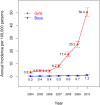A Significant Increase in the Incidence of Central Precocious Puberty among Korean Girls from 2004 to 2010
- PMID: 26539988
- PMCID: PMC4634943
- DOI: 10.1371/journal.pone.0141844
A Significant Increase in the Incidence of Central Precocious Puberty among Korean Girls from 2004 to 2010
Abstract
Background: Few studies have explored the trends in central precocious puberty (CPP) in Asian populations. This study assessed the prevalence and annual incidence of CPP among Korean children.
Methods: Using data from the Korean Health Insurance Review Agency from 2004 to 2010, we reviewed the records of 21,351 children, including those registered with a diagnosis of CPP for the first time and those diagnosed with CPP who were treated with gonadotropin-releasing hormone analogs.
Results: The prevalence of CPP was 55.9 per 100,000 girls and 1.7 per 100,000 boys, respectively. The overall incidence of CPP was 15.3 per 100,000 girls, and 0.6 per 100,000 boys. The annual incidence of CPP in girls significantly increased from 3.3 to 50.4 per 100,000 girls; whereas in boys, it gradually increased from 0.3 to 1.2 per 100,000 boys. The annual incidence of CPP in girls consistently increased at all ages year by year, with greater increases at older ages (≥6 years of age), and smaller increases in girls aged < 6 years. In contrast, the annual incidence remained relatively constant in boys aged < 8 years, while a small increase was observed only in boys aged 8 years. The increase of annual incidence showed significant differences depending on age and gender (P <0.0001).
Conclusions: The annual incidence of CPP has substantially increased among Korean girls over the past 7 years. Continued monitoring of CPP trends among Korean children will be informative.
Conflict of interest statement
Figures
References
-
- Klein KO. Precocious puberty: who has it? Who should be treated? J Clin Endocrinol Metab. 1999. February;84(2):411–4. - PubMed
MeSH terms
Substances
LinkOut - more resources
Full Text Sources
Other Literature Sources
Miscellaneous


